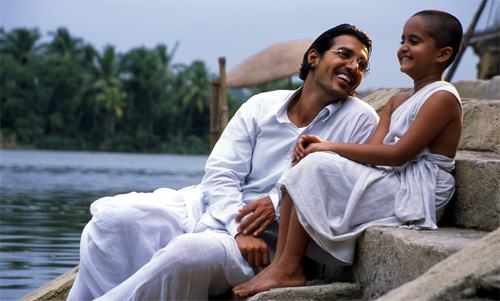Exclusive Premium Content
Deepa Mehta’s Controversial Water Revisited

Deepa Mehta’ s Water , which was released on 9 March ,2007, belongs to that rare category of films that has the power to re-define the parameters of cinema, to re-align the function and purpose of the medium, and to re-structure the way we, the audience look at the motion -picture experience.
It’s no coincidence that Deepa Mehta’s heroine is named Kalyani . Lisa Ray as the tragic but irradiant widow seems to echo Nutan’s Kalyani in Bimal Roy’
The burning ghats and the waters that flow from them, symbolize the ashes-and-embers predicament of Deepa’s ashram-bound women….all plagued by the pathos of dereliction , deprivation and yes, prostitution.In telling it like it is, Mehta never filches. When has she ever done that?! Her elemental trilogy(Fire, Earth & Water) reflects a harshly uncompromising sensibility.
In Water Mehta doesn’t beautify the brutality of the widows’ existence. There are bouts of humour, dance and music(watch Lisa Ray and little Sarala dance around their dingy room as the rain splashes romantically on the parched streets down below, or the eruption of Holi revelry in the ashram). A quality of luminous lyricism runs through the narration, specially in the romantic interludes between Narayan(John Abraham) and Kalyani(Lisa Ray) which are designed like a modern-day re-working of the Radha-Krishna mythology.The sheer purity and beauty of the central romance contrasts tellingly with the squalidity of the lives and settings that the plot negotiates with such slender but deft steps.
Whether it’s in capturing the layer after emotional layer in this onion of a drama or in juxtaposing sequences of the shimmering river with the run-down ashram, Giles Nuttgen’s camera doesn’t flinch from the beauty and the grime. The cinematography could’ve easily converted the multi-layered character-study into a touristic over-view. Nuttgen takes us into the darkest areas of the human condition to search for the peace that prevails under the panic of existence. And A.R Rahman’s music, his best in (y)ears, uplifts the mood of tragic pathos to the sphere of sublimity.
Many moments in Water would comfortably qualify as Pure Cinema. That moment when the oldest woman in the ashram devours a laddoo that she had been craving for all her life could be seen as the most satirically tragic juncture in a film on socio-culturally challenged lives.Water as the giver and the destroyer…that’s the predominant metaphor that cuts through heart of the fragile but for tale.
Each time we see the porcelain Kalyani peep out of her dungeon-like window, we know she’s searching for a horizon that most of us never find in our lifetime.
Water contours and defines those glazed regions in our history that we would rather not sharp-focus on. In many ways its depiction of the plight of abandoned widows is a metaphor for the condition of women across the world, and also a microcosmic view of the human condition. In one way or another we are all persecuted and haunted.
A film like Water comes once in a while to negotiate that seemingly insurmountable space between desire and longing, between love and rituals. As in all works of true art, no character in Water is big or small. They are all played by actors who know what needs to be done, and how to bridge that gap between delusional reality and illusional artistry. The fine cast grabs your undivided attention. Seasoned performers like Manorama(playing the head of the ashram she’s a conniving scheming farting mass of vulgarity and self-interest), Seema Biswas(
It’s Sarala as little Chuhiya whom you’ll find hard to get out of your head. She is the most credible child performer ,on a par with Ayesha Kapoor in Sanjay Bhansali’s Black. Normally children in films respond to adult situations in an unnaturally knowing way. Chuhiya remains a child caught in a frightening world of persecution and perversion.Like bolts of blue feelings , Deepa Mehta inter-cuts the wretched lives of the characters with glimmers of hope.
Even when Mahatma Gandhi makes an unexpected appearance at the end the director doesn’t allow her vision of poetry to be crowded by postures of polemics.While you grieve for these doomed disintegrating lives, you cannot miss the subtext of social reform that underlines their lives. The hallmark of a true work of art is the level of sublimity it achieves in its characterizations while conveying thoughts on the quality of lives. What Deepa Mehta has to say about the plight of women in India 75 years ago remains true to this day. Hopefully things will change before another 75 years pass.
Water leaves us with much hope, and some frightening misgivings.
